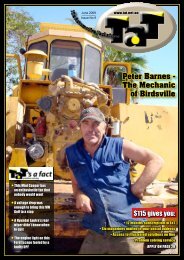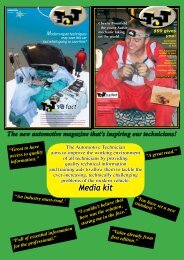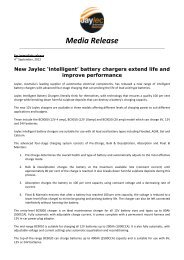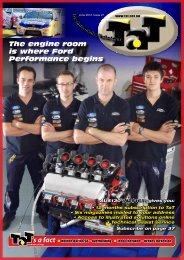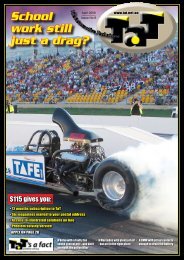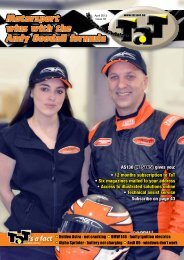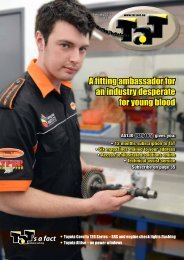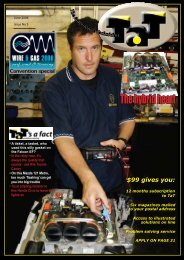What really does cause induction contamination? - TAT - The ...
What really does cause induction contamination? - TAT - The ...
What really does cause induction contamination? - TAT - The ...
You also want an ePaper? Increase the reach of your titles
YUMPU automatically turns print PDFs into web optimized ePapers that Google loves.
Good vibrations for accessory unit drive<br />
<strong>The</strong> engine combustion cycle<br />
accelerates and decelerates the<br />
rotary motion of the crankshaft. This<br />
rotational imbalance is transferred to the<br />
front end accessory unit drive.<br />
1.<br />
and improve the service life of belt drive<br />
components and fuel consumption.<br />
For a long time, the rigid belt pulley (pic 2)<br />
was the standard pulley used on an alternator.<br />
With a design pre-dating V-ribbed pulleys with<br />
3. 5.<br />
recommends replacement at a service interval.<br />
A decoupler (pic 3) is an alternator belt pulley<br />
that powers the alternator by means of a<br />
soft torsion spring. It absorbs the rotational<br />
imbalance, thus preventing torque fluctuations.<br />
Sample assembly drive indicating vibrations <strong>cause</strong>d<br />
by the use of a conventional rigid belt pulley on an<br />
alternator.<br />
As a result, the belt is subjected to strong<br />
vibrations (pic 1) causing unpleasant juddering<br />
noises. Increased torque fluctuations and<br />
extreme forces can occur on the alternator in<br />
particular.<br />
Two key pieces of technology have been tested<br />
with the aim of combating these negative<br />
effects on the assembly drive – overrunning<br />
alternator pulley and decoupler. <strong>The</strong>se<br />
components will enhance driving comfort<br />
2.<br />
Rigid belt pulley<br />
Decoupler<br />
(1) Ball bearing (2) Clutch (3) Friction bearing<br />
(4) Torsion spring (5) Outer ring with moulded race<br />
(6) Cover<br />
one groove, the rigid belt pulleys have been<br />
developed further so that they can be used with<br />
modern V-ribbed belts with multiple grooves.<br />
<strong>The</strong> sole function of the rigid belt pulley is to<br />
drive the alternator by means of the looped<br />
belt. <strong>The</strong> belt needs to be replaced only in<br />
the event of damage, corrosion or significant<br />
wear and tear, unless the vehicle manufacturer<br />
4.<br />
Overrunning alternator pulley<br />
(1) Serrated inner ring (2) Radial support bearing<br />
(3) Overrunning clutch unit (4) Seals (5) Outer ring<br />
with moulded race (6) Cover<br />
Special tools for fitting and removing different<br />
overrunning alternator pulleys.<br />
<strong>The</strong> dynamic forces on the component bearing<br />
points within the assembly drive decrease,<br />
while the belt tensioner and the V-ribbed belt<br />
are protected against damage.<br />
An overrunning alternator pulley (pic 4,5)<br />
features an overrunning clutch unit. This<br />
enables the alternator to be decoupled from the<br />
rotational imbalance on the crankshaft and the<br />
effects of the alternator’s moment of inertia on<br />
the assembly drive and the belt vibrations are<br />
significantly reduced as a result.<br />
<strong>The</strong> force within the assembly drive is reduced,<br />
and the tensioner, pulleys and belts are<br />
subjected to smaller loads and have a longer<br />
service life.<br />
Schaeffler provided valuable assistance in the<br />
preparation of this article.To order your copy<br />
of the INA technical movie comparing Overrun<br />
Alternator Pulley (OAP), Overrun Alternator<br />
Decoupler (OAD) and solid pulleys, please<br />
contact:<br />
02 8977 1038 INA-AS.au@Schaeffler.com<br />
<strong>The</strong> Automotive Technician 11



